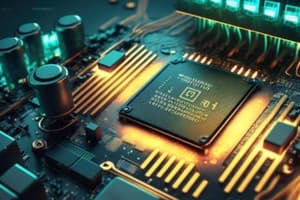Podcast
Questions and Answers
What is the primary function of the CPU in the Von Neumann architecture?
What is the primary function of the CPU in the Von Neumann architecture?
- To facilitate input and output operations
- To integrate electronic circuits
- To store data and programs
- To process arithmetic and logical instructions (correct)
What is the term for the exponential growth in the number of transistors on a microchip?
What is the term for the exponential growth in the number of transistors on a microchip?
- Super Large Scale Integration
- Von Neumann's Principle
- Moore's Law (correct)
- Large Scale Integration
What was the significant advancement in the 1980s that led to an increase in processing power?
What was the significant advancement in the 1980s that led to an increase in processing power?
- Introduction of the first personal computer
- Integration of 3 million components on a single chip (correct)
- Development of the microprocessor
- Advancements in Super Large Scale Integration
What is the name of the first binary programmable computer based on the Von Neumann architecture?
What is the name of the first binary programmable computer based on the Von Neumann architecture?
What is the term for the integration of complete CPU on a single chip?
What is the term for the integration of complete CPU on a single chip?
What was the significance of 1981 in the context of personal computers?
What was the significance of 1981 in the context of personal computers?
What is the term for the integration of approximately 10^6 components on a single IC?
What is the term for the integration of approximately 10^6 components on a single IC?
Study Notes
CPU in Von Neumann Architecture
- The primary function of the CPU is to execute instructions, perform calculations, and manage data flow within the computer system.
Exponential Growth of Transistors
- The term "Moore's Law" refers to the exponential growth in the number of transistors on a microchip, predicting a doubling of transistors approximately every two years.
Advancements in the 1980s
- The introduction of the microprocessor in the 1980s marked a significant advancement, enabling greater processing power and efficiency in computers.
First Binary Programmable Computer
- The first binary programmable computer based on the Von Neumann architecture is the ENIAC (Electronic Numerical Integrator and Computer), which used binary data representation.
Integration of CPU on a Single Chip
- The term "System on a Chip" (SoC) describes the integration of a complete CPU and other components on a single semiconductor chip, enhancing performance and reducing size.
Significance of 1981 in Personal Computers
- In 1981, IBM released its first personal computer (PC), establishing a standard that led to widespread adoption of personal computing.
Integration of Components on an IC
- The term "Very Large Scale Integration" (VLSI) describes the integration of approximately 1 million components on a single integrated circuit (IC), revolutionizing electronics and computer design.
Studying That Suits You
Use AI to generate personalized quizzes and flashcards to suit your learning preferences.
Description
Learn about the Von Neumann architecture, which includes a CPU, memory, input/output devices, and communication channels. ENIAC was the first binary programmable computer based on this architecture.





